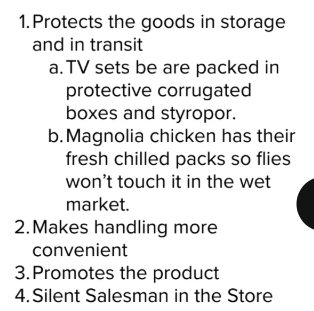Module 4A Value Creation (No product life cycle)
1/49
There's no tags or description
Looks like no tags are added yet.
Name | Mastery | Learn | Test | Matching | Spaced |
|---|
No study sessions yet.
50 Terms
Core benefit
the main reason for
buying a product; what the customer is
really buying
Generic/basic product
basic version of
a product
Expected product
a set of attributes
and conditions that buyers normally
expect and agree to when they purchase
this product.
Augmented product
a product that
includes additional services and benefits that
distinguish the company’s offer from the
competitor’s offer. These normally exceed
expectations.
Potential product
all the augmentation
and transformation which this product might
undergo in the future.
FIVE LEVELS OF PRODUCT
(CUSTOMER VALUE
HIERARCHY)
Core benefit
Generic/basic product
Expected product
Augmented Product
Potential product
Need family
the core need that underlies the product family.
(e.g. health and beauty)
Product family
all the product classes than can satisfy a core
need with reasonable effectiveness. (e.g. health and beauty aids)
Product class
a group of products within a product family
recognized as having certain functional coherence. (e.g. hair care
products)
Product line
a group of products within a product class that
are closely related because they function in a similar manner or
are sold to the same customer or groups or are marketed
through the same types of outlets or fall within given price
ranges. (e.g. shampoo and conditioner)
Product type
those items within the product line that
share one of several possible forms of the product. (e.g
conditioning shampoo)
Brand
the name associated with one or more items in
the product line that is used to identify the source or
character of the item. (e.g. rejoice conditioning shampoo)
Item
a distinct unit within a brand or product line that is
distinguishable by size, price, appearance, or some
attribute. (e.g. rejoice conditioning shampoo in sachet)
Product/Brand Hierarchy
Need Family
Product Family
Product class
Product line
Product type
Brand
Item
Product
Anything that can be offered to a market for attention,
acquisition, use or consumption that might satisfy a
want or need.
According to
tangibility
CONSUMER
PRODUCT
CLASSIFICATIONS
Durable goods
Non-durable
goods
Services
According to
shopping habits
CONSUMER
PRODUCT
CLASSIFICATIONS
Convenience goods
Staples Shopping goods
Specialty goods
Unsought goods
Industrial Product
classifications
CONSUMER
PRODUCT
CLASSIFICATIONS
Materials and parts
Capital items
Manufactured materials and parts
PRODUCT MIX
Set of all the product lines and items that a particular
seller offers for sale to buyers. Also called product
assortment.
Width
Length
Depth
Consistency
Product Mix is described in terms of
Width
refers to how many different product lines the
company carries
Length
refers to the number of items in its product mix
Depth
refers to how many variants are offered of each
product in the line.
Consistency
refers to how closely related the product
lines are.
Product line managers
need to know the sales
and profits of each item in the line in order to
determine which items to build, maintain, harvest
or divest.
marketer
To analyze a product line, the _____ must
know the sales and profit figures, product line
market profile (how the product is positioned
against its competitor) and product line length.
Line stretching
occurs when a company lengthens its product lines
beyond its current range.
Downward stretching or down-market stretch
The company is attacked by a competitor at the high end and
decides to counterattack by invading the competitor’s low
end.
Upward stretching or up-market stretch
entering the higher end (due to higher profits,
higher margins or to position as full-line
manufacturers)
Two way stretch
where companies serving
the middle market might decide to stretch the
line in both directions (upward and downwards).
Line Pruning Decision
dropping deadwoods.
Brand
a name, term, sign, or symbol that identifies the maker or seller of the product
Identification
Importance of branding
Brands enable
consumers to easily distinguish one
product from another.
Protection
Importance of branding
It enables the owner of the
brand name to enjoy the goodwill
associated with the name so as not to
be taken advantage by others.
Positioning
Importance of branding
It enables the owner to
communicate the benefits of his
product vis-a-vis competition.
Brand name
part of the brand which can be
vocalized
Brand mark
cannot be vocalized but
associated & recognizable
Trademark
given local protection
BRAND EQUITY
Four Levels of Attitude Towards a Brand
a. Customer has no loyalty. Customer will
change brands, especially for price reasons.
No brand loyalty.
b. Customer is satisfied. Customer is satisfied.
No reason to change the brand.
c. Customer values brand. Customer values the
brand and sees it as a friend.
d. Customer is devoted. Customer is devoted to
the brand.
BRAND IDENTITY
Intended brand meaning the want to convey
Building brand identity: name, logo, color,
tagline, symbol
BRAND POSITIONING
Where a brand stands in benefits in the minds
of the consumers relative to competitive
brands.
Better positioned if name is associated with
benefit.
BRAND PERSONALITY
the brands associated human traits. A brand can
be better positioned by associating its
name with a desirable benefit.
BRAND CHARACTERISTICS
In terms of integrity, honesty & trustworthiness
BRAND IMAGE
the way the brand is perceived by the market
BRAND ASSOCIATION
A brand will trigger many associations related to
attributes, benefits, attitudes, etc.
o The association should be examined with respect to:
1. Favorability of association
2. Strength of association
3. Uniqueness of association
BRAND STRATEGY DECISIONS
Line extension. Existing product
category, existing name (coke
zero, life, sakto)
Brand extension. Existing brand
name, new product (ABS CBN
Mobile)
Multi branding. Existing product,
new brand name (UFC oil)
BRAND NAME GUIDELINES
Good brand names
Distinctive
Suggests quality
Good looking if written down, and
sounds good
Suggests benefits
Easy to pronounce
Evoke an emotion, feeling or idea
(i.e FedEx)
Must represent you
Benefits from packaging

FUNCTIONS OF LABEL
1.Identify the product/brand
Can it attract consumers? An example
is a comparison of a four-color print
versus a black and white package
2.Grade the product
3.Promote the Product